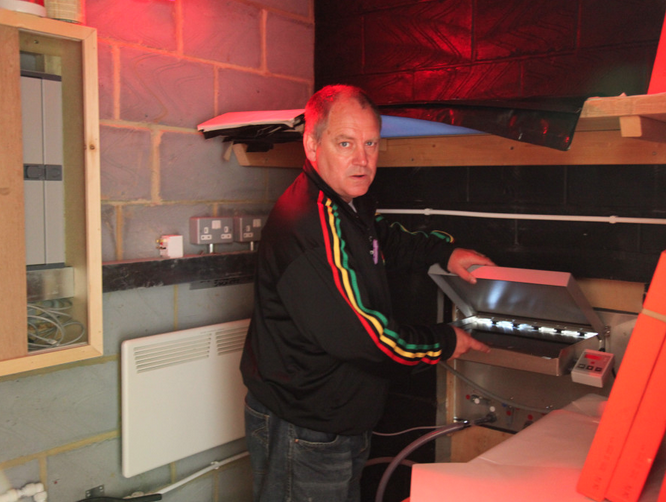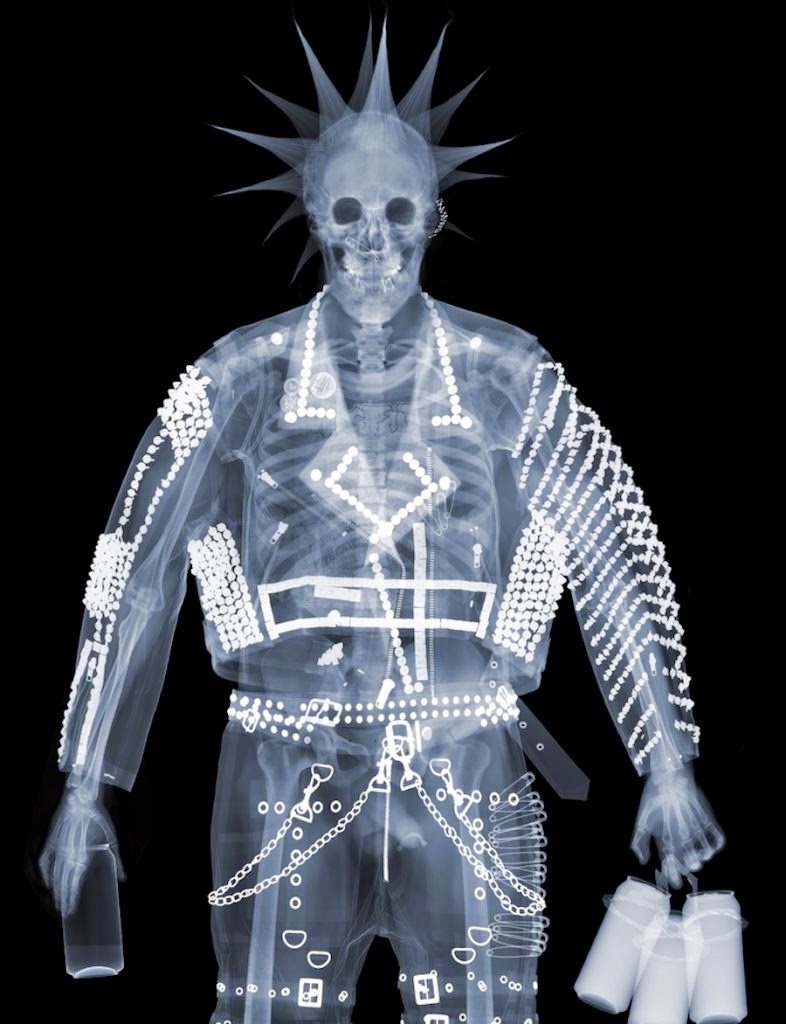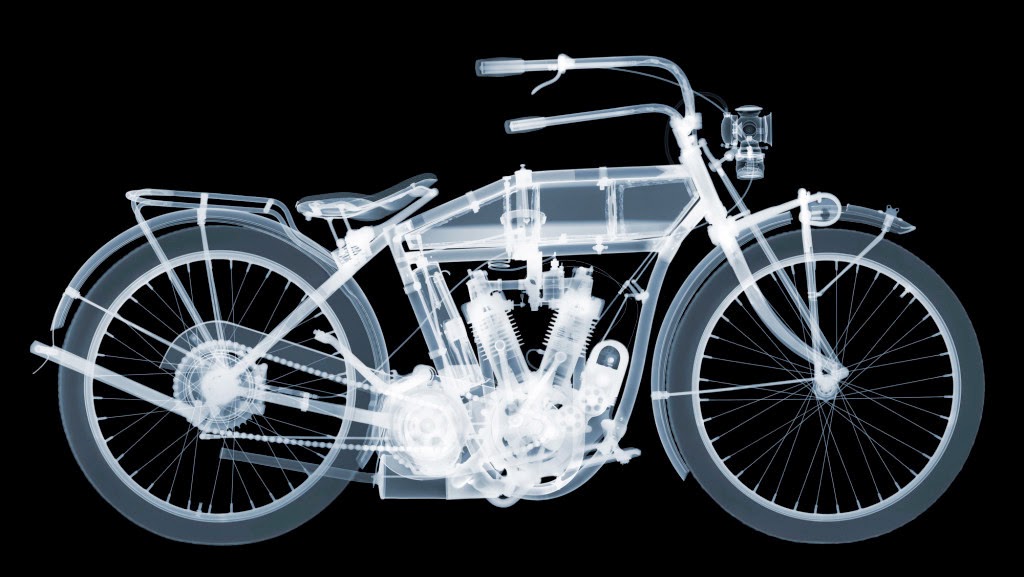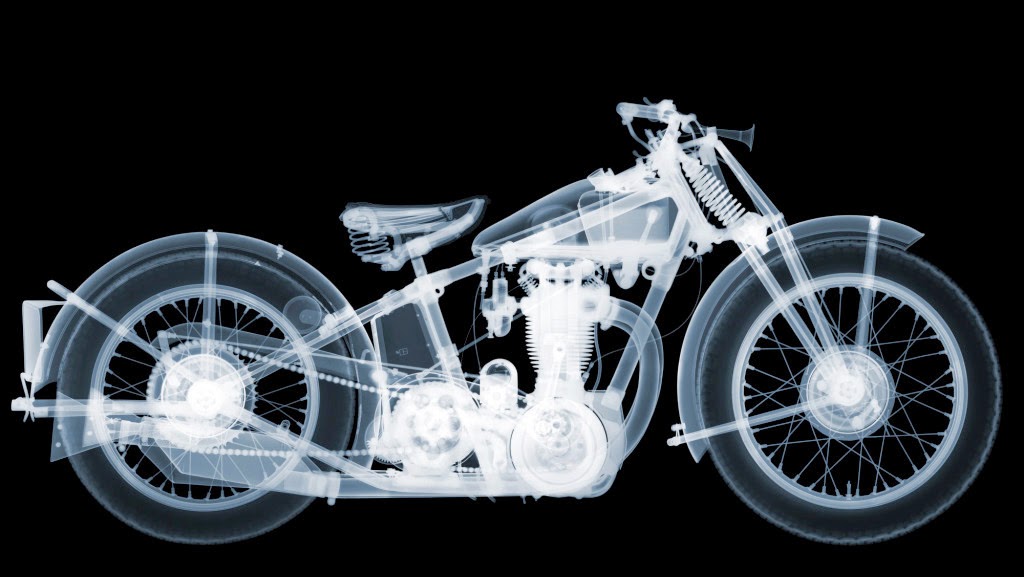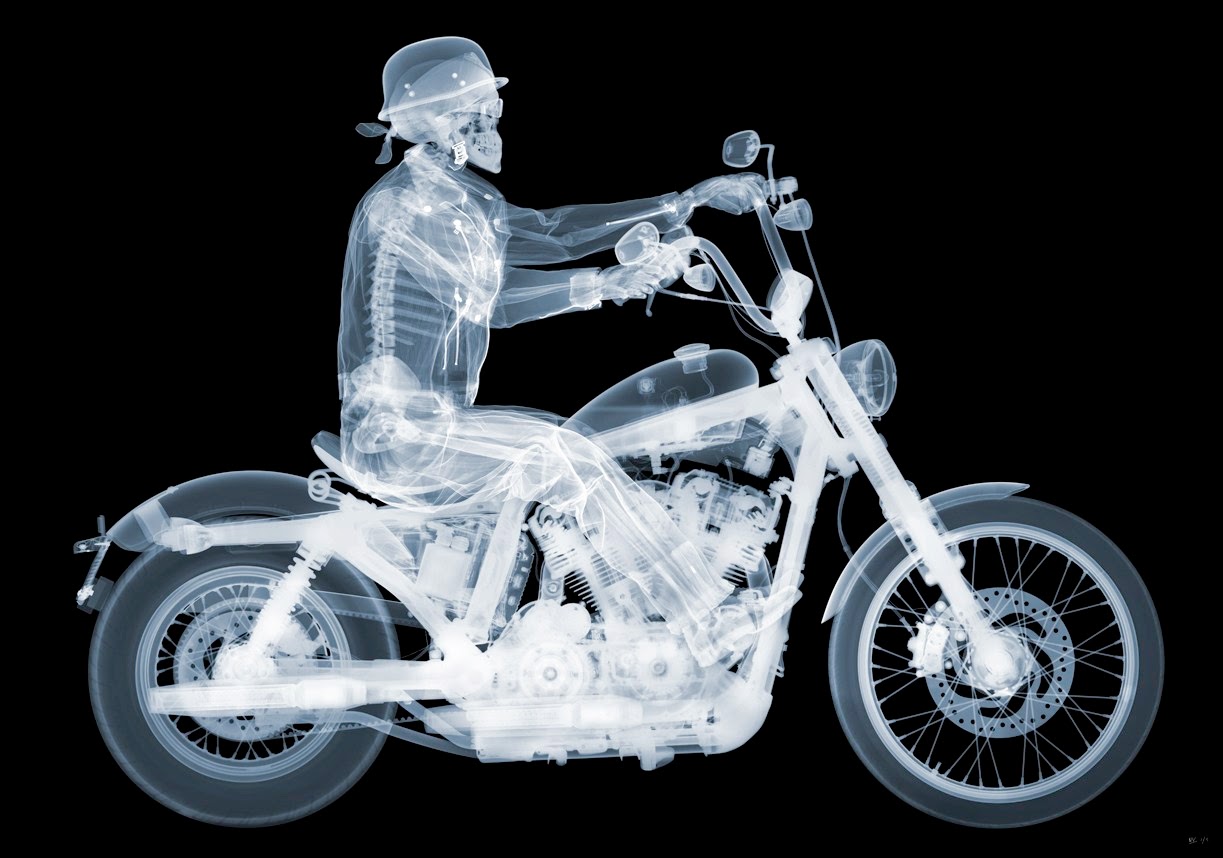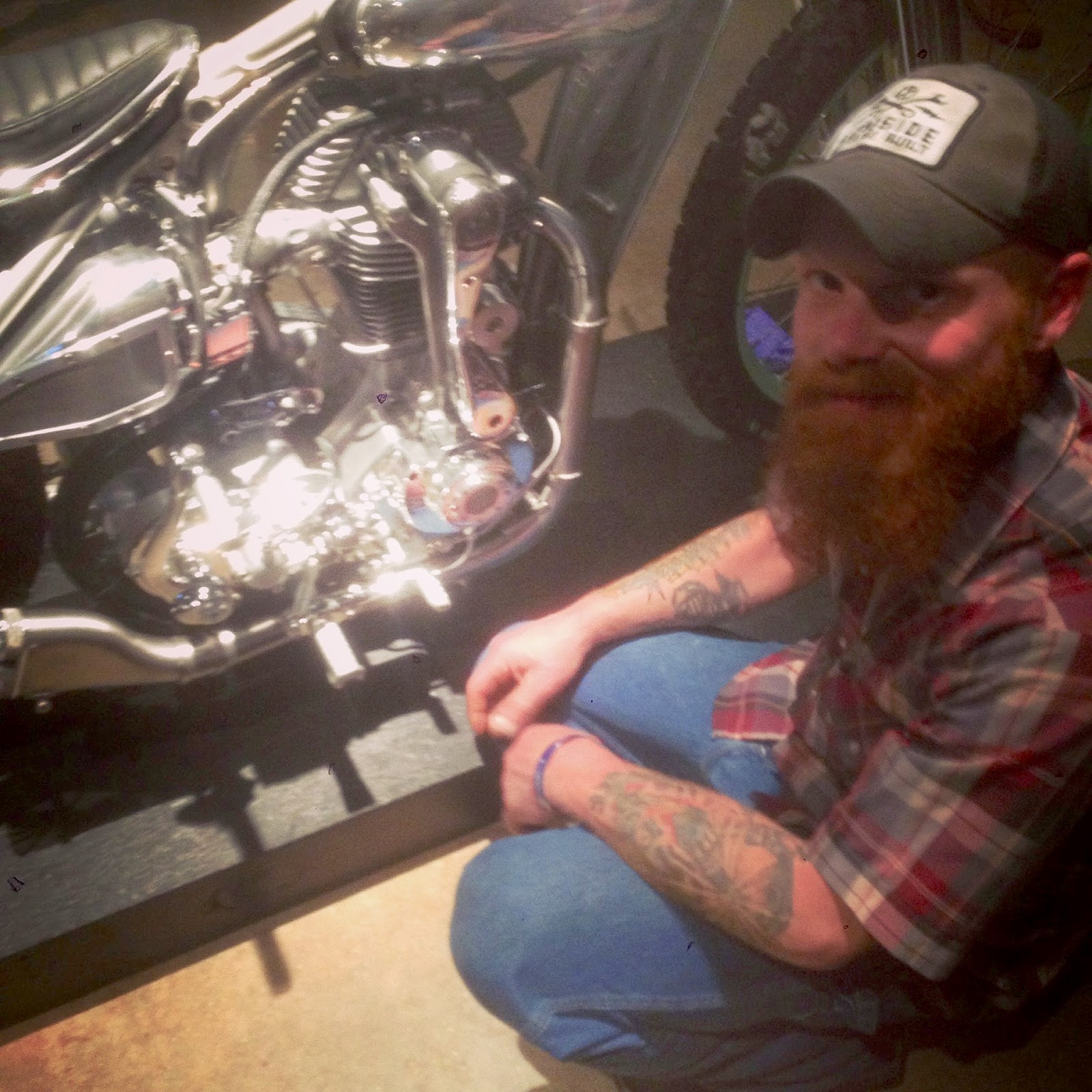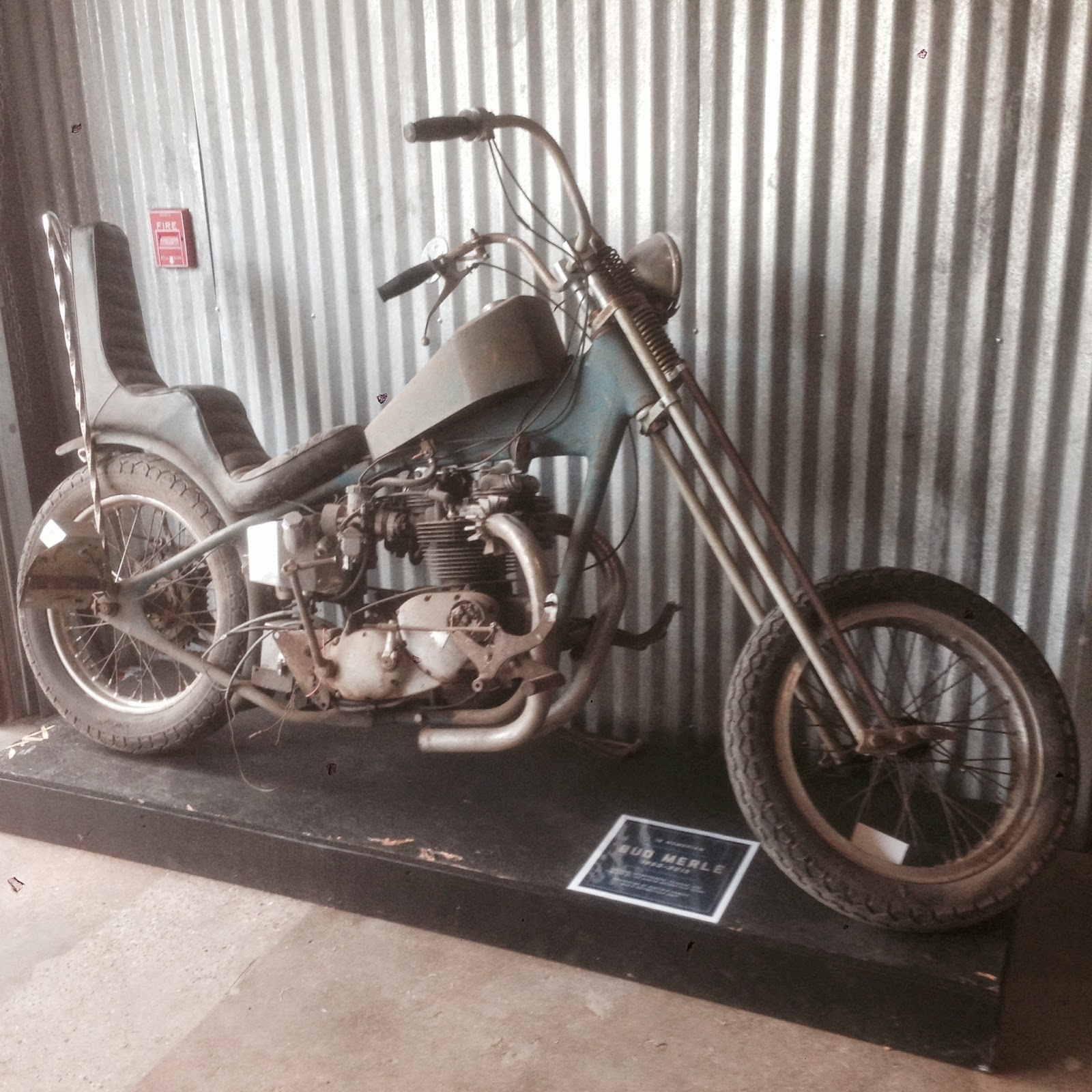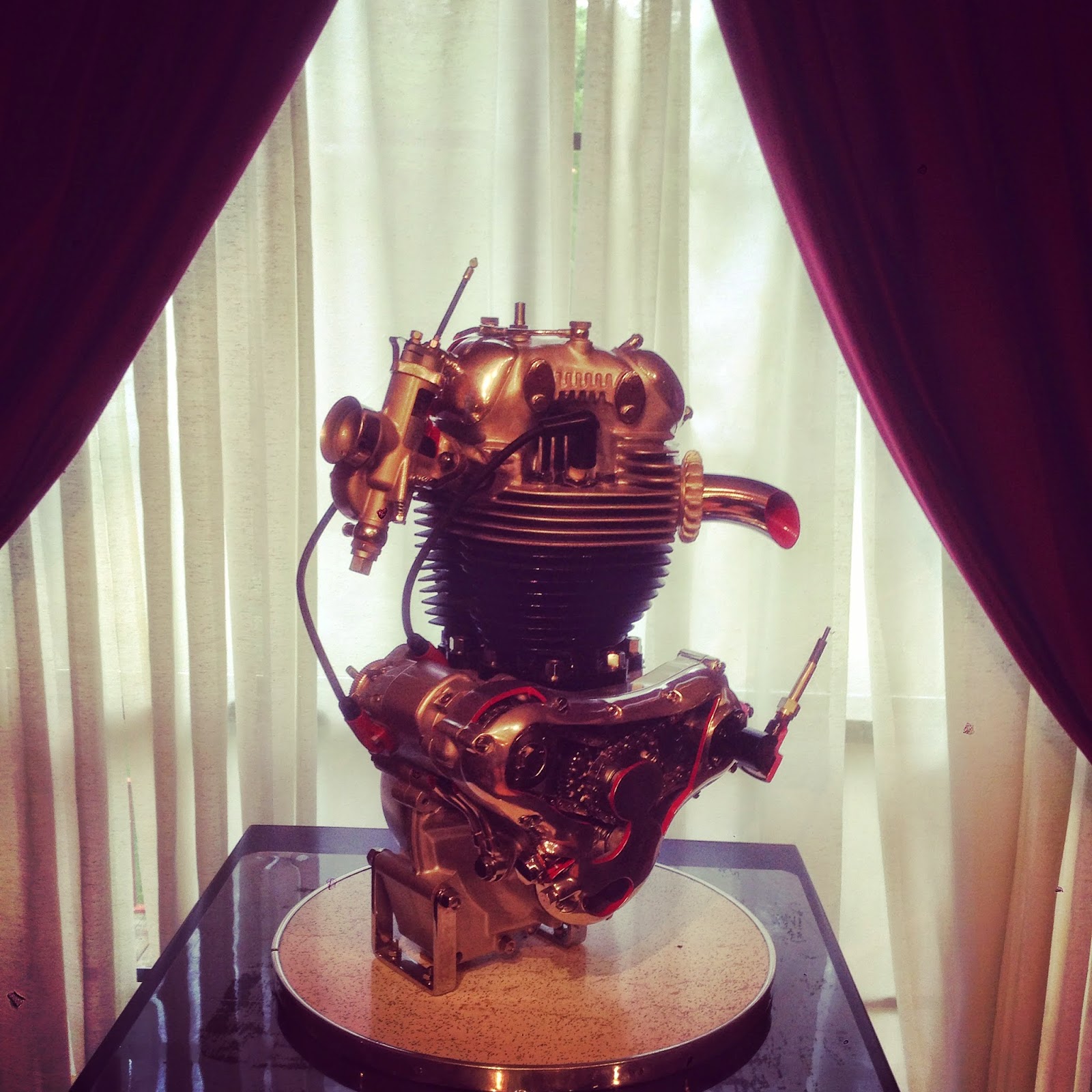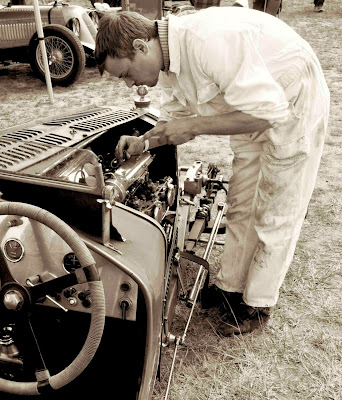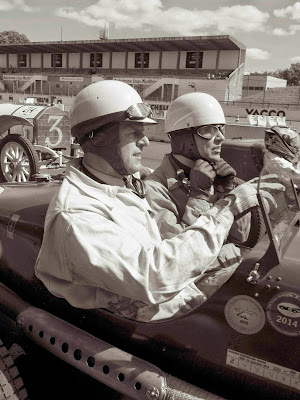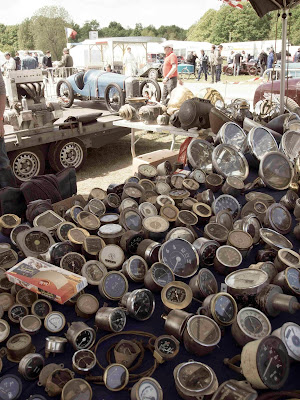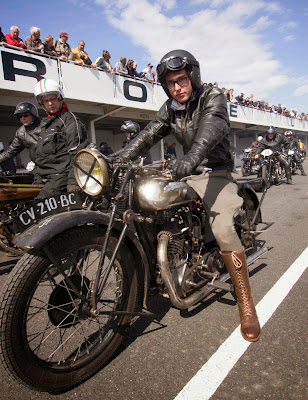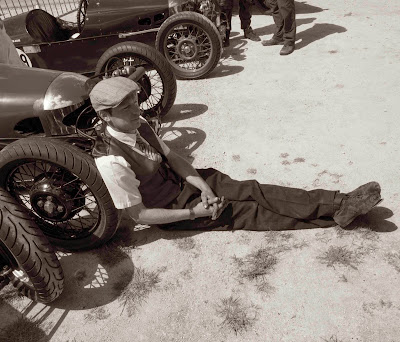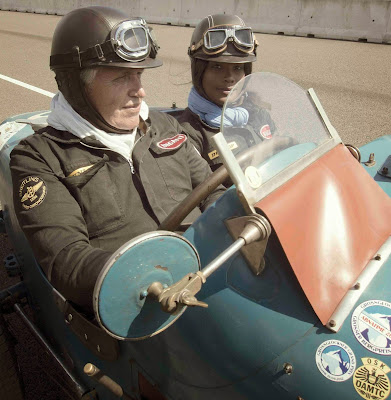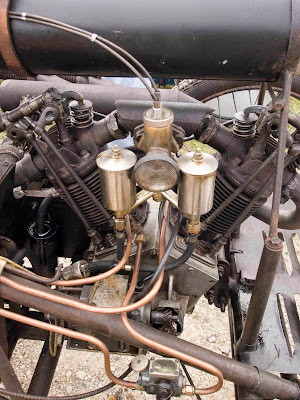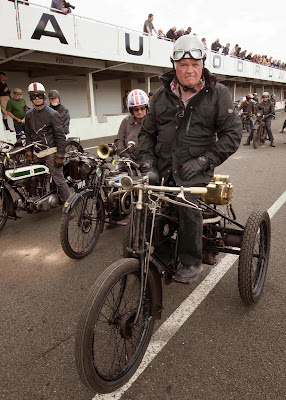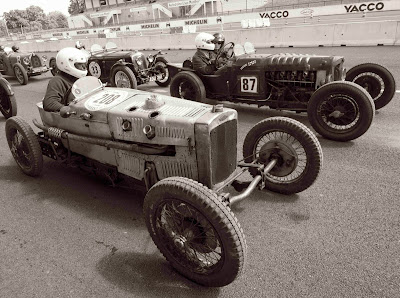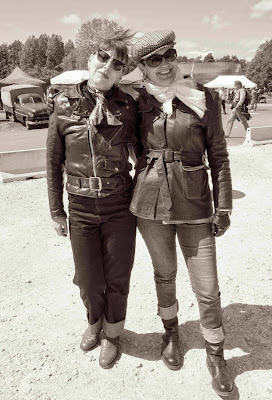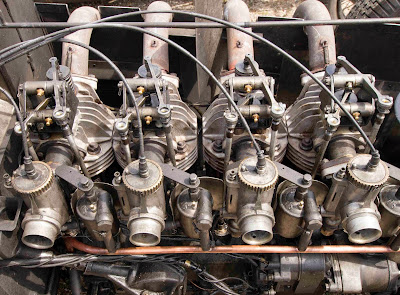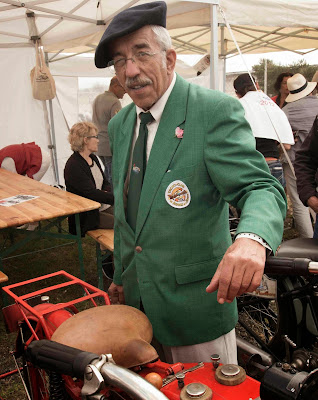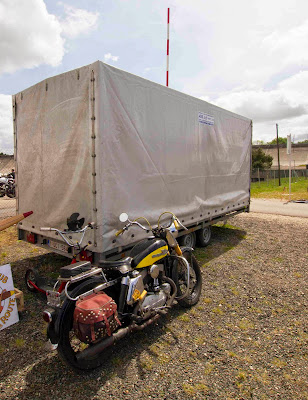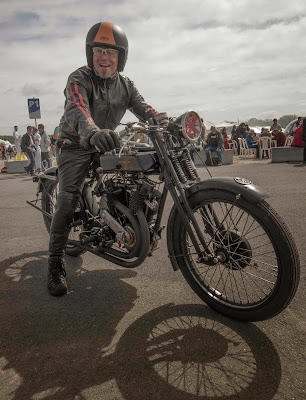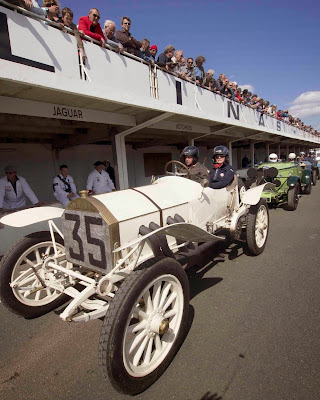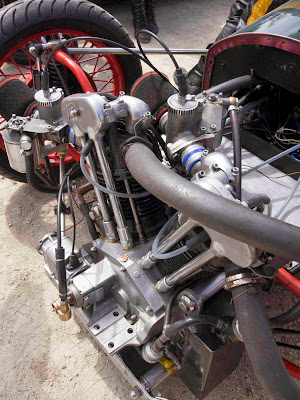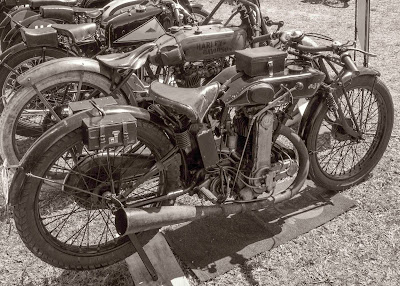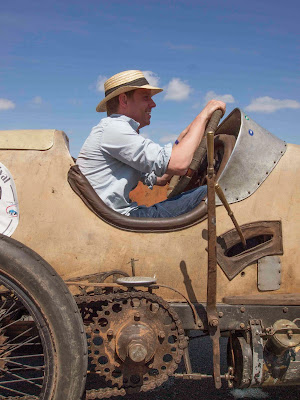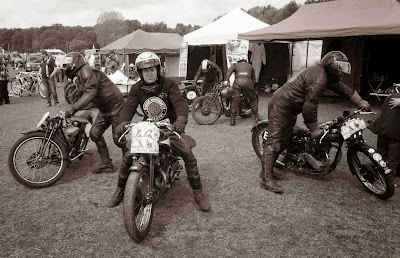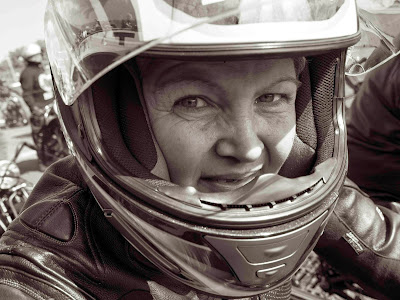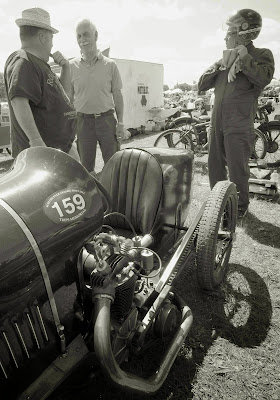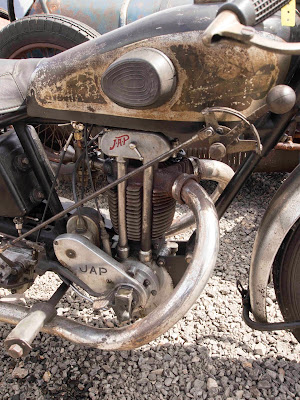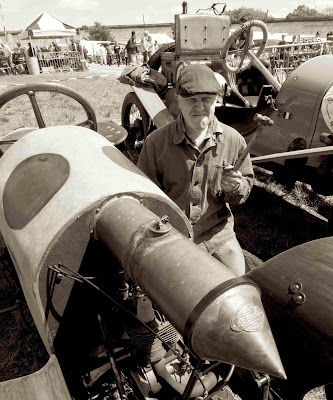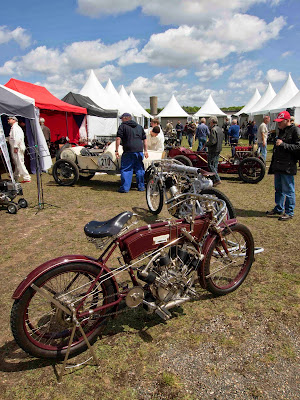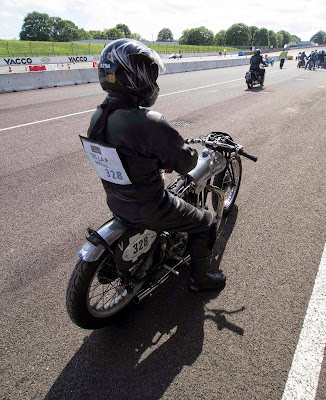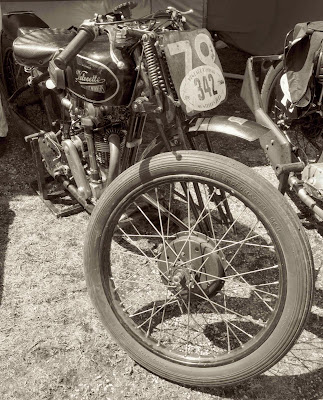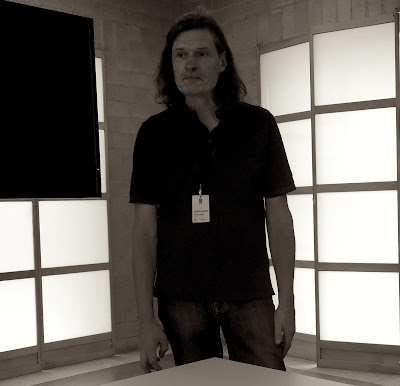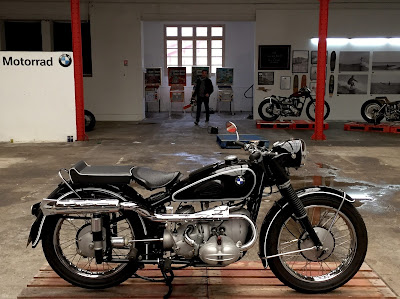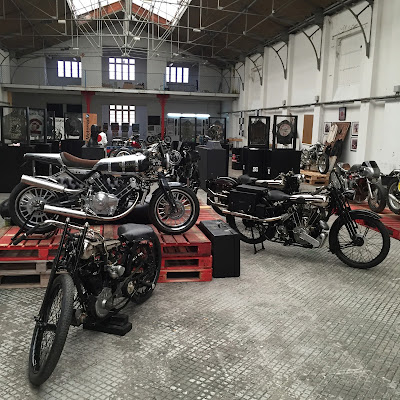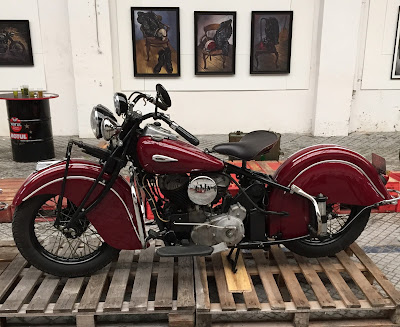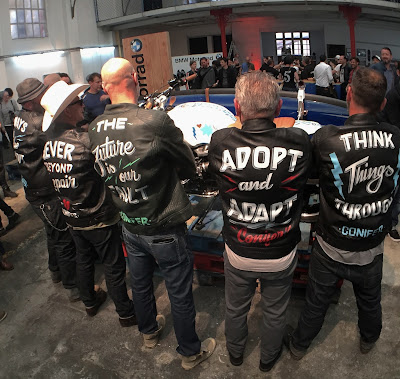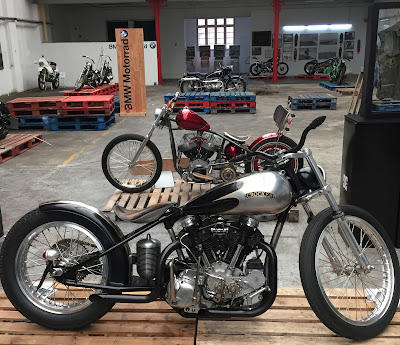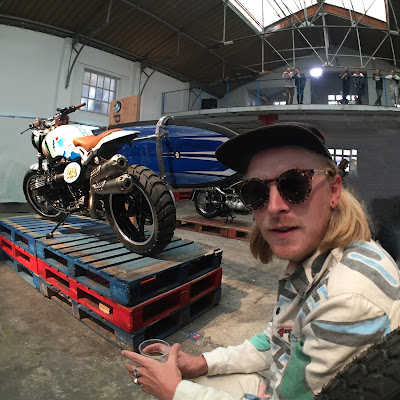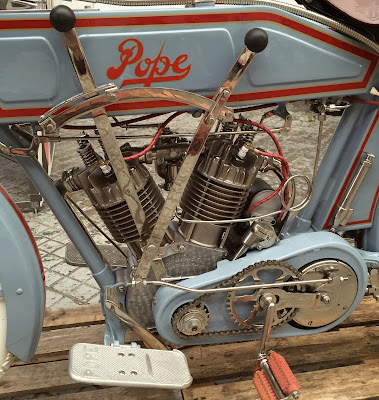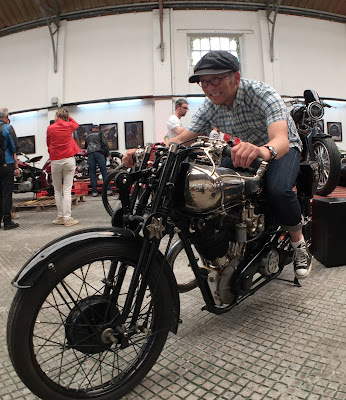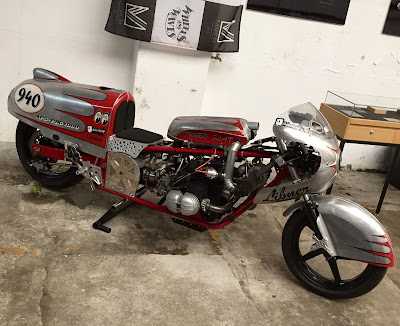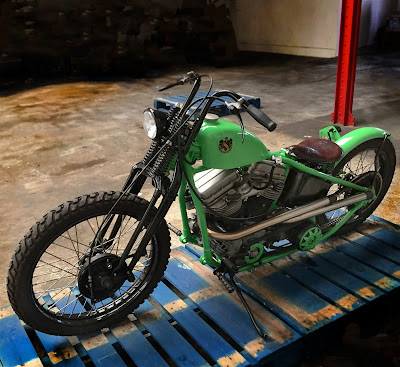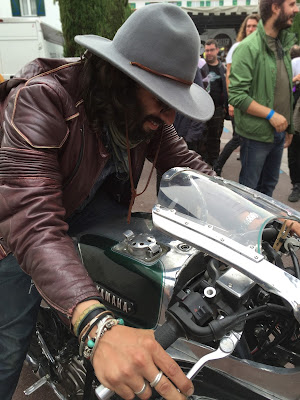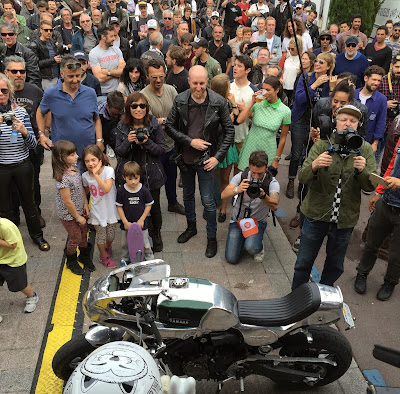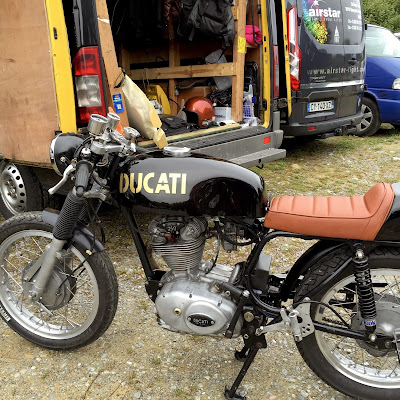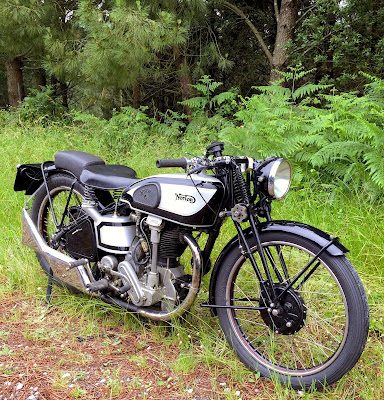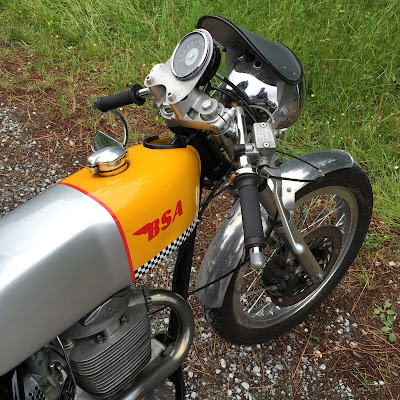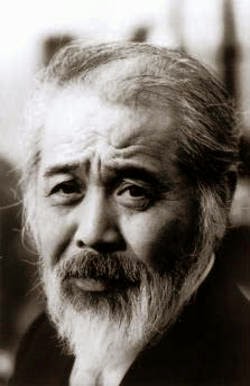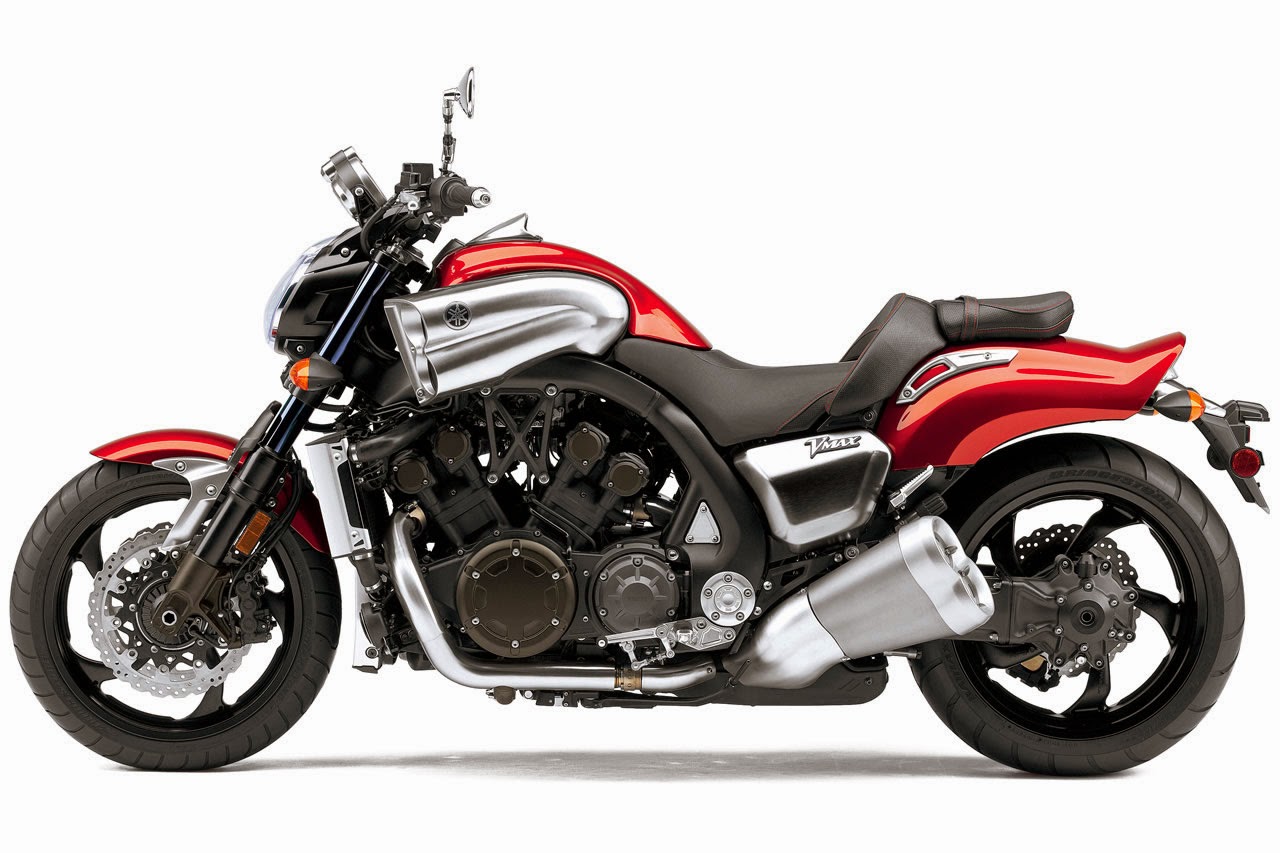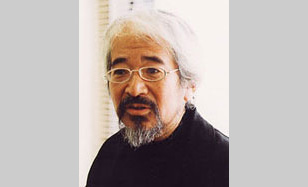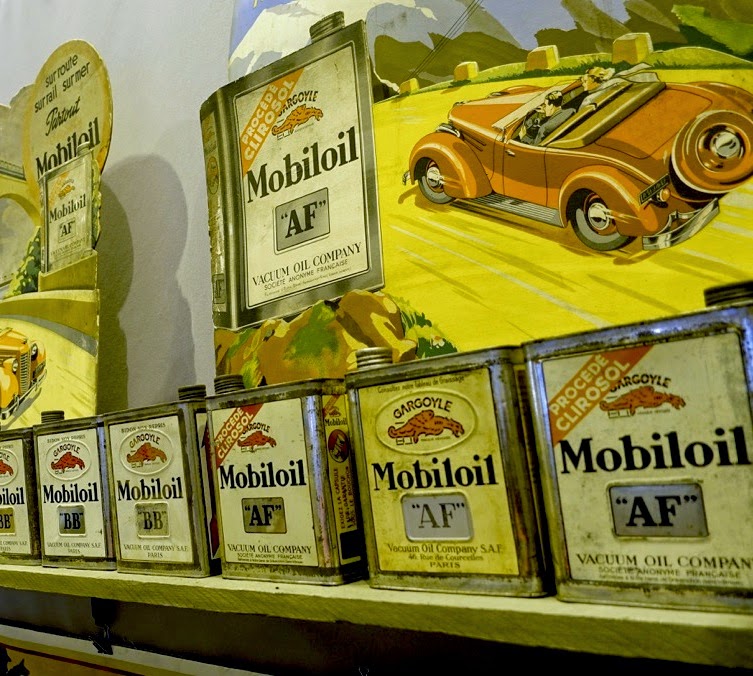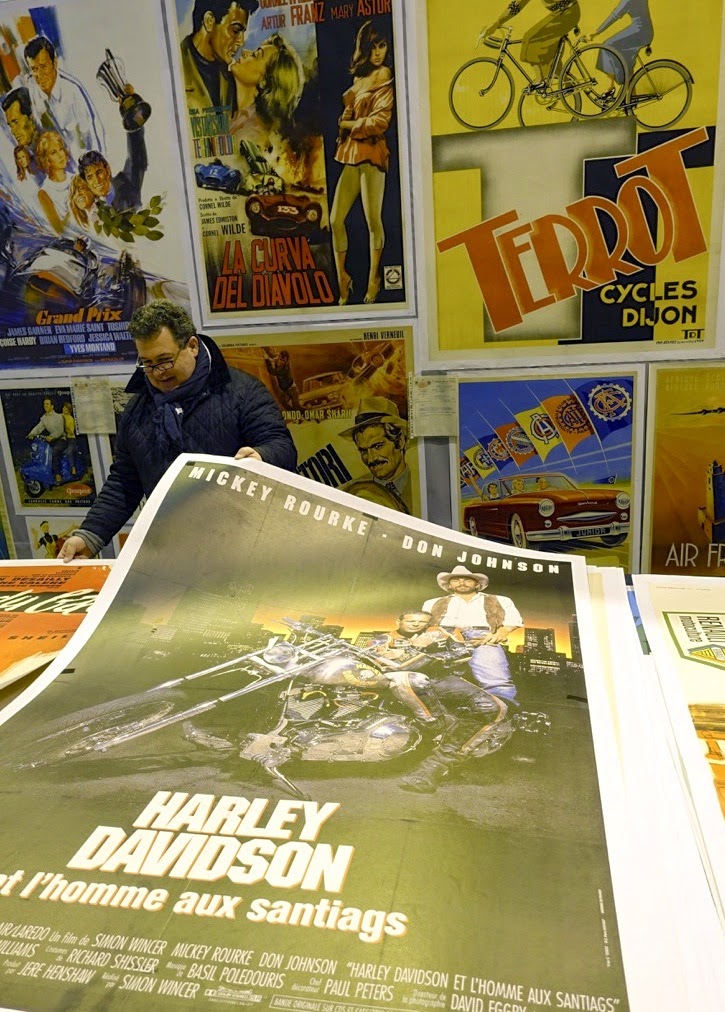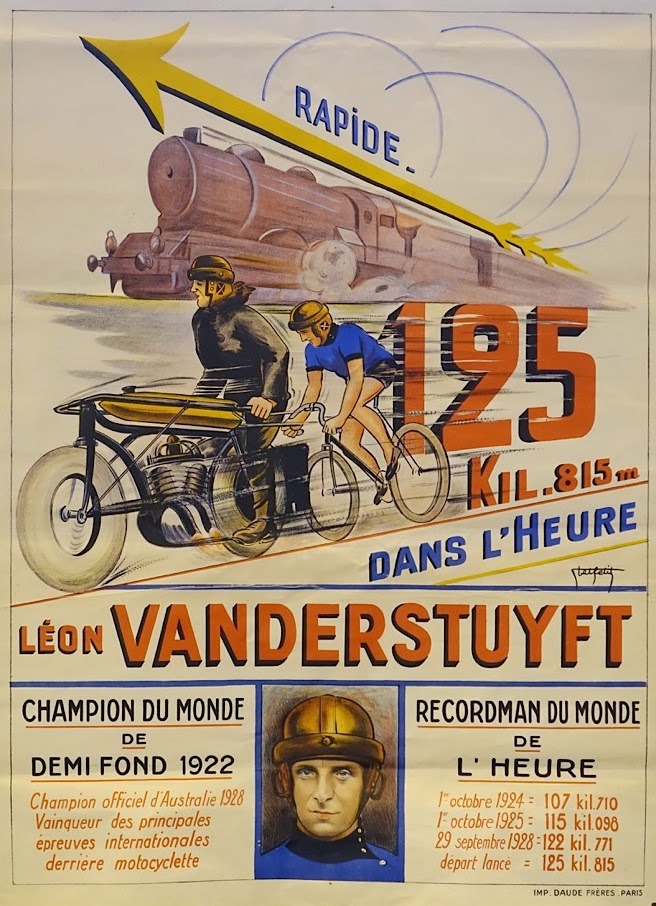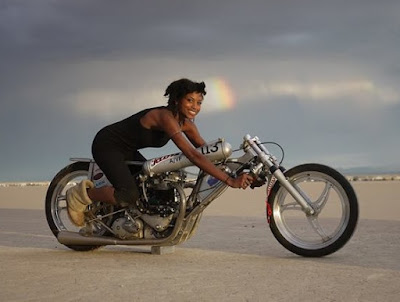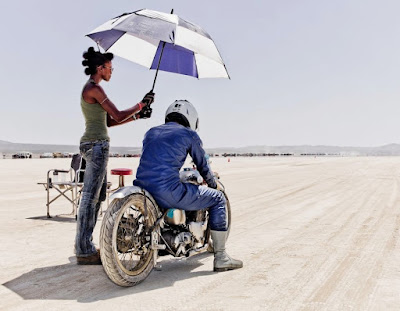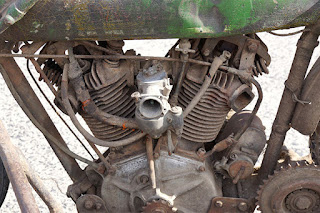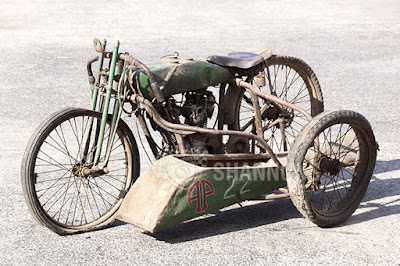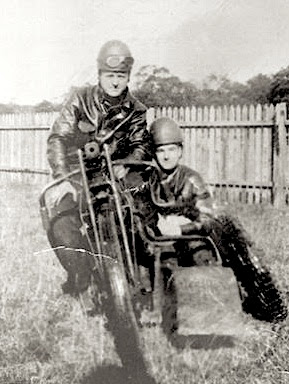![]() |
| Alain deCadenet aboard the ex-John Edgar, Rollie Free 'bathing suit' Vincent, one of the world's most famous motorcycles |
MIGHTY MO'BIKE HAS STRUCK OUT The outlook wasn't brilliant for a Pebble judge that day,
As bikes stood proudly two by two, all winners - so they say.
And then a gent claimed Gunga Din was faked up, though a looker,
And partly by a judge there, a good man who is no hooker.
But Gunga, true to Kipling's muse, did sally forth, a win,
While lovers of old Rollie Free's machine called it a sin.
That year another prize was took, a streamlined Indian,
T'was claimed to be from Burt Munro, but some said ‘guess again’.
What part was Burt's and what part new, nobody there would tell,
But surely he who built the thing is answerable to Hell.
![]() |
| The recreation of the famous Vincent racer 'Gunga Din' |
A silence like a cloak covers the patrons of this game,
The millions stashed from ticket sales protecting them from shame.
A straggling few raised protest for the fakery, and more -
The bolstering of class divides was something to abhor.
Some clung yet to hope which springs eternal in our breast;
They thought, “Surely Pebble Beach will always do its best.
While motorcars are one thing, motorbikes are something new,
Perhaps a whole new game's afoot, Class X is now on view!”
The Guggenheim had sung their praise, the Art of Motorcycles;
The Legends Show had proved that bikes on grass could be delightful.
![]() |
| An Excelsior Super X racer, built of a mix of old and new parts, and patinated to look well-used |
Cycling through each country who'd built bikes in times before,
Was the theme at Pebble Beach on hallowed golf link shores.
But country categories surely limited the choices,
Unlike grouping cars by factory - Ferraris and Rolls Royces.
The country theme as annual display proved ill-considered,
Though those first few nations featured proved their bike were worthy winners.
Collectors spent a bundle prepping rare machines to show,
Like the Hildebrand and Wolfmuller that simply wouldn’t go.
The year of Italy’s display was best, with bikes after the ‘Thirties,
My MV pic was in the New York Times, ‘cause of John Surtees.
![]() |
| The French lineup, included several lightweights of mixed quality. |
A few years in, the choice grew thin, as was indeed the entry,
One year they featured Vietnam, with one sad rolling sentry.
The French theme fell as flat as a meringue from a hack chef,
We shan't speak of Eastern Europe's year; good possibles were left
In museums and collections far across the ocean's span,
It seems foreigner collectors did not support the plan.
“Fly in your bike, at your own cost, of course,” they all were told,
Which - from the richest of all shows - seemed brazen, crass, and bold.
American collectors had been told but did ignore it,
That racers run on pavement since the ‘Teens were most historic.
Their dirt-track kings and board track bikes were hounded to obsession,
Which meant when Pebble called ‘GP!’ there’s none in their collections.
![]() |
| My photograph of John Surtees aboard his World Championship MV Agusta was used in a New York Times article decrying his lack of knighthood for his double World Championship status, on cars and bikes - still the only man to have done this. |
There was a time not long ago when motorbikes were fashion,
And car collectors far and wide declared a new-found passion,
For motorbikes collectible, much cheaper than four wheels,
And set about to write big checks for seven-figure deals.
With polished skin and suits that cost as much as a new ride,
They suddenly appeared at auctions, advisors by their side,
Who earned commissions from the Millions in old-bike finance,
By overlooking inconvenient truths ‘bout provenance.
But 6 years on, the thrill is gone, and car folks have decided,
That tin and doors and solid floors is what gets them excited.
Organizer Sandra and her minions sniffed the trends,
So earlier this year decreed that Pebble bikes would end.
![]() |
| A nautical theme! Rumi made submarines and torpedos in WW2... hence the anchor logo |
Oh, somewhere on a twisty road the sun is shining bright,
A motorbike is purring and the rider's found delight,
With the joy of simply riding an old bike - though valued highly -
The ownership of which marks vintagents as money-wily.
True joy from motorbikes is motion, not the money game,
Though bikes in galleries these days would not suggest the same.
Two wheels make lousy sculptures; better riding them around,
The greedy types are merely vultures, much like car guys, I have found.
The Concours thing is tempting with big money all about,
But there is no joy from Pebble — motorbikes are pencilled out.
![]() |
| Christine Reed graces John Stein's amazing Ducati Imola racer |
[And in case you don't read the excellent publication 'The Automobile' from England - the best old-car magazine in the world - I wrote the following account of the 2013 Pebble Beach Concours on their request. I didn't expect them to publish it, at least not without serious editing, but editor Jonathan Rishton chose to print it 100% as written, saying,
"Thanks for the report. It is superb - one of the best, most insightful and honest things we'll have ever published. Thanks so much."Nothing has changed at Pebble since then, except the raising of ticket prices to $350, and the elimination of motorcycles. Enjoy the read - it's a scandal!]
![]() |
| Exotic car design emphasized swelling curves from the '30s onwards |
OCCUPY PEBBLE BEACH! c.Paul d'Orléans 2013
Welcome to Pebble Beach, a grand celebration of the important things in life; status, wealth, tiered access, covetousness, and the need for a good hat. The Devil is at play on that green seaside lawn, tempting car enthusiasts worldwide towards the very worst reasons to enjoy old automobiles, and having quite a successful run at it. Just as Capital currently reigns unchallenged over our globe, so Pebble is the acknowledged King of Concours d’Elegance. Pebble Beach Sunday has become, in a world of exciting youth culture battling threats of economic, environmental, and military calamity, a strange 1% Otherworld, a money-cushioned respite from reality, for a mere $225 admission ($275 at the gate).
![]() |
| The Paul Poiret-designed interior fabric for Voisin cars - not to be viewed on psychedelic drugs! |
D’Elegance it is not, unless your definition includes constant elbow-bashing and the impossibility of getting a clear photograph of a car you like…at least Pebble’s photo-bombers are well dressed, and if you’re crafty, will include a revealingly dressed trophy wife. Huzzah. I find it hard to find joy in this event; the cars are magnificent, the best examples of over-the-top design in the world without question, but surely I am not a voice in the wilderness in finding it crass, materialistic, horribly boring and an overcrowded clusterfuck.
![]() |
| Pebble is an opportunity for period-correct dress, for some |
Let me rephrase that: Pebble Beach is no joy to attend, although one is pampered as an entrant. The price of admission to that club varies by your ambition and your pocketbook; a savvy choice of an obscure but important vehicle might not be expensive at all – you may already own one – but positioning yourself for an ‘invitation’ is another matter, and will require connections to the right people. Or at least, in the four-wheel categories… a back door has opened in the last 5 years for collectors of important motorcycles, which are only as expensive as good cars were 25 years ago; ie, generally under $100k.
![]() |
| 'In the Spring a young man's fancy turns lightly to thoughts of abolishing the tax on Capital Gains' |
That will change of course, but for now, if you’re really hankering to stand beside a vehicle all day, waiting for judges to pore over your machine, then waiting some more to find if you’ve placed, then a motorcycle is the way to go. This year would have been the perfect opportunity, actually, as the motorcycle theme was ‘French’. If you’re not from that country, I challenge you to name more than four French motorcycle manufacturers. Don’t feel bad, neither could the Pebble organizers, who failed to round up prime examples of French engineering prowess - the exotic overhead-cams, the racers, the multi-valves, the incredible range of ‘firsts’ from the early years, when France dominated vehicular achievement on land and in the air. No significant history was in evidence.
![]() |
| Too much love; over-rubbed in sensitive places? |
The earliest two-wheeler on the lawn was the only good reason to visit Class X; the 1929 Majestic was a unique example, having an American four-cylinder Cleveland engine completely enclosed in Deco-sausage bodywork, with car-like hub center steering; a two-wheeled Facel Vega. The Majestic was produced 63 years into the lineage of French motorcycling (a genre they invented, after all, in 1867), which leaves a whole lot of unexplained history in a tiny field of only 9 motorcycles. It was simply embarrassing. I say let’s just forget this pathetic attempt at ‘inclusion’; motorcycles ARE the new black, but nobody’s wearing black at Pebble. Or perhaps, let’s ask Karl Lagerfeld to curate the next motorcycle exhibit, and cut the pretense to relevance, or History, or whatever.
![]() |
| Birds shedding feathers. |
The automotive display included a stretch of competition-minded Porsche 911s to celebrate that squidgy little darling’s 50th birthday, and I must say we’ve grown old well together. It’s lovely seeing full-scale the Corgi Porsches I vroomed as a lad, although if one took a 20 minute drive from the golf club lawn, one could see, hear, and smell some of the very same cars being hammered around Laguna Seca raceway in the Monterey Historics, where megamillion Ferraris are spun into barriers and semi-genteel Aston Martins bash each other’s noses. The damage inflicted on these glorious beasts is costly, like every one of the 40,000 spectators lighting a joint with a $10 bill. Still, I’d rather watch the beasts howling and writhing and stressing themselves, than parked on a lawn.
![]() |
| Our man deCadenet 'splaining an Alfa 8C, an example of which he's owned for donkey's ears |
An excellent Pebble development is the ever-expanding ‘preservation’ classes (L-1 and L-2, pre- and postwar), which means somebody at Pebble has heard the clarion call of the Oily Rag. Hallelujah. My favorite rust-bucket was an original-paint Voisin, complete with dents, which was dutifully polished all day long, one assumes to help remove more areas of paint for the ‘perfect patina’. The interior, I was assured, was in the original leather, and not the eye-watering Paul Poiret Art Deco mescaline nightmare found in every single restored Voisin; they’ve really come out of the woodwork since winning ‘everything’ in the past 2 years.
![]() |
| Further over-loved; a Voisin in original paint, but perhaps not original interior? Although it was old... |
I was slightly vexed by an Aston Martin DB5 in supposedly original paint, its anthracite grey exterior looking fairly immaculate barring rubbed-thru patches where clearly ‘over-loved’ by the polishing rag…or was this new paint, artfully distressed? The thought disturbed me, the more so when I overheard a Preservation class entrant describing the purchase of a junked car’s faded leather interior, which he placed in his own car, as it looked better. Creatively ‘original’, but certainly not ‘preserved’, unless we count an aggregation of vintage parts as ‘original’ in toto…at which point, there’ll be no need to lock up the guns, my mind will have already been blown.
![]() |
| 'If you come any closer, I'll whack you with my vintage stacked-agate walking stick.' |
It’s a not-joke that only black cars win Best in Show at Pebble Beach [2015 too! - pd'o], and this year was no exception; the 1934 Packard 1108 Twelve Dietrich Convertible Victoria was the first American car to win the grand prize since 2007. It was big and grand and utterly unique, partly because America was starving at the time, out of work with a 40% unemployment rate. Brother, can you spare a coachbuilt Packard?
![]() |
| Top of the Money Tree, even in an odd shade of green; a Ferrari 250GTO in a Billion dollar lineup |
Today, if the owner falls on hard times, he can always follow the path of last year’s winner, who sold his 2012 Best in Show ’28 Mercedes-Benz 680S Torpedo Roadster for a cool $8.25M on the weekend. That was nothing, of course, compared to the 1967 Ferrari 275 GTB/4S NART Spider, which sold for a chart-busting $27.5M…shades of pre-Crash giddiness. “
It’s almost 2014: do you know where your investments are?”![]() |
| The ex-John Surtees Ferrari normally found in the Barber Museum |
The Centenary of Aston Martin did not pass unnoticed, and a lovely stretch of racers and roadsters were nearly camouflaged by the British racing green lawn, although the insect-yellow flash of a ’57 DBR2 kept bumblers alert. Its livery was matched by a new Aston CC100 Speedster prototype, shown in the ‘Concept Car Corral’ on the Lodge lawn, and looking a lot like BMW’s ‘328 nouveaux’ concept débuted in 2011, but sexier. Bugatti brought a special-edition Veyron for display at an invite-only party, and a pair of gilded guests had a bidding brawl on the spot, resulting in the $2.7M car which wasn’t for sale leaving the premises for nearly $3.5M. Wallets thrown at 10 paces; may the best oligarch win. The piss-taking side events like the Monterey Concours d’LeMons are looking like a better bet every year…

